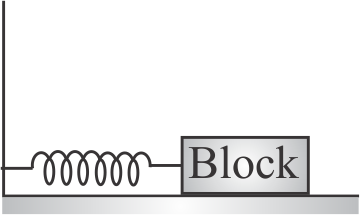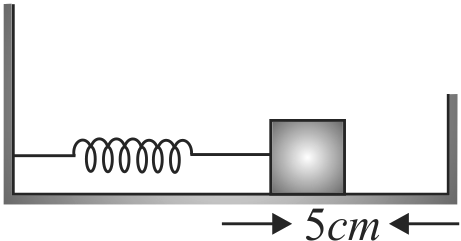364409
For a simple harmonic motion in a mass spring system shown, the surface is frictionless. When the mass of the block is \(1\;kg\), the angular
frequency is \({\omega _1}\). When the mass is \(2\;kg\) the angular frequency is \({\omega _2}\). The ratio \({\omega _2}/{\omega _1}\) is
364410
A block of mass \(100\;g\) attached to a spring of spring constant \(100\;N{\rm{/}}m\) is lying on a frictionless floor as shown. The block is moved to compress the spring by \(10\;cm\) and then released. If the collisions with the wall in front are elastic, then the time period of the motion is: (Given \(\pi^{2}=10\) )
364409
For a simple harmonic motion in a mass spring system shown, the surface is frictionless. When the mass of the block is \(1\;kg\), the angular
frequency is \({\omega _1}\). When the mass is \(2\;kg\) the angular frequency is \({\omega _2}\). The ratio \({\omega _2}/{\omega _1}\) is
364410
A block of mass \(100\;g\) attached to a spring of spring constant \(100\;N{\rm{/}}m\) is lying on a frictionless floor as shown. The block is moved to compress the spring by \(10\;cm\) and then released. If the collisions with the wall in front are elastic, then the time period of the motion is: (Given \(\pi^{2}=10\) )
364409
For a simple harmonic motion in a mass spring system shown, the surface is frictionless. When the mass of the block is \(1\;kg\), the angular
frequency is \({\omega _1}\). When the mass is \(2\;kg\) the angular frequency is \({\omega _2}\). The ratio \({\omega _2}/{\omega _1}\) is
364410
A block of mass \(100\;g\) attached to a spring of spring constant \(100\;N{\rm{/}}m\) is lying on a frictionless floor as shown. The block is moved to compress the spring by \(10\;cm\) and then released. If the collisions with the wall in front are elastic, then the time period of the motion is: (Given \(\pi^{2}=10\) )
364409
For a simple harmonic motion in a mass spring system shown, the surface is frictionless. When the mass of the block is \(1\;kg\), the angular
frequency is \({\omega _1}\). When the mass is \(2\;kg\) the angular frequency is \({\omega _2}\). The ratio \({\omega _2}/{\omega _1}\) is
364410
A block of mass \(100\;g\) attached to a spring of spring constant \(100\;N{\rm{/}}m\) is lying on a frictionless floor as shown. The block is moved to compress the spring by \(10\;cm\) and then released. If the collisions with the wall in front are elastic, then the time period of the motion is: (Given \(\pi^{2}=10\) )
